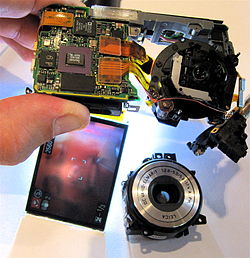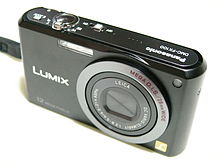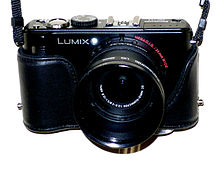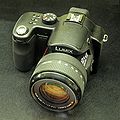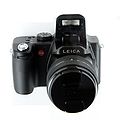- Lumix
-
Lumix is Panasonic's brand of digital cameras, ranging from pocket point-and-shoot models to digital SLRs.
Compact digital camera DMC-LC5[1] and DMC-F7[2] were the first products of the Lumix series released in 2001. They are equipped with Leica lenses.
Many Lumix models are fitted with Leica lenses designed by Leica's German optical engineers and are assembled in Japan. Others are rebranded as Leica cameras with different cosmetic stylings. Leica had a similar relationship with Minolta in the past, where late model Leica SLRs (and some 35mm point and shoot models) were strongly based on Minolta bodies.
Most Lumix cameras use different releases of the Panasonic Venus Engine for digital image processing; the original version (2002) was followed by II (2004), Plus (2005), III (2006), IV (2008), HD, V (2009), and VI, HD II, FHD (2010).
Panasonic produces all of Leica's branded digital point and shoot cameras in Japan, but not film cameras, the Leica M8 or Leica M9 digital rangefinder cameras, or the Digital Modul R digital camera back for the Leica R9 film SLR.
Panasonic showed a prototype of a planned 3D Lumix camera in September 2011,[3] saying that it would have twin 4× zoom lenses with folding optics and optical image stabilization for both video and still images.[3]
Contents
Model lines
Some cameras come in several colours, indicated by a suffix letter: K is black, S silver, A blue, R red, W white. Most lower-price cameras have small sensors of about 10.2 mm / 1/2.5". More expensive ones often have sensors of about twice the area, 14.1 mm to 15.4 mm / 1/1.65" to 1/1.8". dSLRs and Micro Four Thirds cameras have much larger sensors. Larger sensors produce a better signal-to-image-noise ratio and better dynamic range. The GH series of Micro Four Thirds cameras have a unique 'multi-aspect' sensor, that is larger than the lens image circle. This allows use of three different aspect ratios, 4:3, 3:2 and 16:9, to be used natively. As a result, the image diagonal remains the same in all three aspect ratios and provides full coverage of the sensor and a larger field of view with higher resolution than one would get by simply cropping the 4:3 aspect to the narrower ratios.
Current
- DMC-FS: Ultra-compact mid-range, relatively typical cameras. The FS range was launched in January 2008. This series includes the FS3, FS4, FS5, FS10, FS20, FS6, FS7, FS15, and, FS42.
- DMC-FX: Ultra-compact high-end, relatively typical cameras. The FX01 was the first ever ultra-compact (considering Ricoh R series as compact) with a true wide-angle 28–102 mm lens, sharing now (20 Jan 2007) this feature with its siblings FX07 and FX50, as well as with the Canon SD800 IS (IXUS 850 IS in Europe). Unlike most of the other Lumix lines, the FX series tends to have a more stylish look (as opposed to the generic silver or black), targeted at social photography. Includes the FX1, FX5, FX2, FX3, FX7, FX8, FX9, FX01, FX10, FX12, FX30, FX37(38), FX50, FX07, FX100, FX33, FX55, FX35, FX150 (1/1.72"), FX500, FX48 (FX40 in Europe), and FX580 (FX550 in Europe). The Panasonic Lumix DMC-FX30 was announced as the world's slimmest camera with a 28 mm equivalent wide-angle lens. The Panasonic Lumix FX35 equips with 25 mm Ultra-Wide-Angle Lens. The FX500 is the first Panasonic to feature a touch-screen interface.
- DMC-FZx (excluding DMC-FZx0 models): Compact ultra-zoom higher-end cameras. These cameras are described as compact but are relatively large, have extensive controls (although models earlier than the FZ7 do not have manual focus), and long zoom ranges, typically 12× with extending zoom lens. Includes FZ1, FZ2, FZ3, FZ4, FZ5, FZ7, FZ8, FZ18 (18× zoom, 1/2.5"), FZ28 (18x zoom, Venus IV) and FZ35/FZ38(Europe) (18x zoom, Venus HD).
- DMC-FZx0: Bridge digital cameras, resemble digital SLRs in many ways, but have a non-interchangeable, non-extending zoom lens. The later models from the FZ30 are large and heavy, have a wide zoom range (12×) and extensive manual controls, including fully manual focus and zoom rings on the lens. The range comprises the FZ10, FZ20, FZ30, and FZ50 (14.1 mm / 1/1.8"). The DMC FZ47 is slated for availability in August 2011.[4]
- DMC-G: Panasonic's Micro Four Thirds System line, advertised as a "reinvented D-SLR" without mirror. The first camera in the line is the G1, released in late 2008, which has an electronic viewfinder (EVF) and interchangeable lens (EVIL class). It does not use the mirror and pentaprism of a true SLR, so is smaller and lighter. It has many of the features of a DSLR and of a compact digital camera, but no movie mode[5]. The GH2 was released in October 2010 as a successor to the GH1 and improves upon the video recording capabilities of its predecessor and incorporates many upgrades such as a higher resolution sensor and the fastest contrast detect autofocus system implemented to date.[6]. In September 2009, Panasonic released the GF1, a 12 megapixel compact Micro Four Thirds camera featuring 720p HD video[7]. This model was followed by the GF2, a smaller version of the GF1, incorporating 1080p HD video.
- DMC-L: Panasonic's DSLR line. It uses the Four Thirds System lens mount and along with the Olympus E-330 was one of the first DSLRs capable of displaying live image view on the LCD screen. Models include the L1 and L10.
- DMC-LCx: LC5 and LC1 are compact ultra high-end cameras.
- DMC-LCxx: A standard compact camera line.
- DMC-LS: Panasonic's cheapest line, budget plastic compact cameras powered by two AA batteries. Includes the LS1, LS2, LS3, LS60, LS70, LS75, LS80, and LS85.
- DMC-LX: A compact high-end camera line, with full manual exposure and focus controls (with joystick control rather than focus ring), and RAW recording, unusual in compact cameras. Includes the 8 megapixels LX1, the 10 megapixels (1/1.65") LX2, and the 10 megapixels (1/1.63") LX3 with a 2.5x f/2–2.8 24–60 mm (35 mm equivalent) lens. (Announced Jul 2008, shipping since late Aug 2008.) The successor to the LX3, the LX5 was announced in July 2010 and features an unchanged 10.1MP (1/1.63") sensor, but with an improved telephoto 3.8x f/2–3.3 24–90 mm (35 mm equivalent) lens[8].
- DMC-LZ: Budget, but more advanced and with more user control than many other digital compact cameras. The most notable feature is a 5× (37–222 mm) optical zoom range. Includes the LZ1, LZ2, LZ3, LZ5, LZ6, LZ7, LZ8, LZ10 (Jul 2008).
- DMC-TS: waterproof, shockproof, and dustproof point and shoot camera. Includes TS1 (FT1), which also has limited high definition video capability.
- DMC-TZ: Compact, point and shoot 10× zoom cameras with image stabilization. Includes the TZ1, TZ2, TZ3, TZ4, TZ5 (Known as the TZ15 in Asia), and TZ50 (TZ5 with Wi-Fi). The TZ1 uses folded optics, with a prism. TZ1's successors use a traditional design without folded optics, hence the barrel extends further out during operation.[9] The TZ series stands out against other compact digital cameras by achieving a 10x optical zoom with a 28 mm* wide angle lens in a small compact body. *equivalent to 35 mm camera. In 2010, Panasonic released the TZ10 (ZS7 in the United States), which has a 12x (25 - 300 mm) optical zoom and incorporates GPS. It also features 720p HD video capability. On January 25th 2011, Lumix DMC-TZ20 (ZS10 in the United States) was announced. Features includes 16x optical zoom (24-384mm (35 mm equivalent)), 14.1 Megapixel MOS, 1080/60i AVCHD video, high speed shooting at 10 frame/s at full resolution, 60 frame/s at 3.5 Mpix resolution and high speed video at 220 frame/s at QVGA resolution.[10]
- DMC-ZS: Compact ultra-zoom high-end (offering HD video) cameras. Announced in January 2009[11] as a successor to the successful TZ series. It is distinguished by having high-grade still shooting and offering HD video functions. Includes ZS1 (TZ6) and ZS3 (TZ7). The ZS3 is advertised as "the world's first digital camera that records motion image in AVCHD Lite", records 720p HD video with stereo audio and has a dedicated video record button (which replaces ZR1's 'extended zoom' button). ZR3 replaces ZR1 in some countries.
Discontinued
DMC-LC: No longer in production. Consisted mostly of medium-compact-size, mid-range cameras, but also included the high-end LC5 and LC1, which were also sold as the Leica Digilux 1 and Digilux 2 respectively.
Model history
Type Venus Engine Non-installing Venus I Venus II Venus Plus Venus III Venus IV Venus HD Venus V Venus VI Venus HD II Venus FHD High-end
Ultra-CompactFX100 FX150 Ultra-Compact, Wide-angle FX01 FX50 / FX30 / FX 55 / FX33 FX35 / FX500 FX580 (FX550) / ZX3 FX48 (FX40) / ZR1 (ZX1) / FP8 FX66 FX78 Ultra-Compact F7 F1 / FX5 / FX1 FX7 / FX2 FX8 / FX3 / FX9 FX12 (FX10) FS3 / FS5 / FS6 / FS7 / FS15 / FS20 / FS25 High-end
CompactLC5 LC1 LX1 LX2 LX3 LX5 Compact, Wide-angle, Large Zoom TZ1 / TZ2 / TZ3 TZ4 / TZ5 / TZ15 / TZ50 / ZS1 (TZ6) ZS3 (TZ7) ZS5 (TZ8) ZS7(TZ10) Compact,
Medium ZoomLZ1 / LZ2 / LZ3 / LZ5 LZ6 / LZ7 LZ8 / LZ10 Compact,
Ultra ZoomFZ1 / FZ2 FZ3 / FZ5 / FZ7 / FZ30 FZ50 / FZ18 / FZ8 FZ28 FZ35 / FZ38 (Europe) FZ100 Compact LC40 / LC20 LC33 / LC43 / LC70 LS1 / LS2 LS60 / LS75 / LS80 LS85 Four Thirds L1 / L10 Micro Four Thirds G1 / GH1 / GF1 G2 GH2 / GF2 / GF3 Waterproof, shockproof, and dustproof TS1 (FT1) TS2 (FT2) TS3 (FT3) Leica model crossover
Some Panasonic and Leica cameras are more or less the same. The differences, other than the obvious exterior styling, are in the camera firmware. Different application software is also supplied by the two companies with the cameras. Claims regarding differing quality control or weatherproofing are unsubstantiated.
The Leica and Panasonic cameras produce the same RAW image, but will process white balance, noise reduction, etc. differently for jpeg output. Lumix cameras are less expensive than their Leica counterparts due to the companies' marketing strategies.
- Lumix L1 vs. Leica Digilux
- Lumix FZ50 vs. Leica V-Lux
- Lumix LX vs. Leica D-Lux
- Lumix FX vs. Leica C-Lux
Promoters
In Japan, pop singer Ayumi Hamasaki promotes the Lumix cameras with her songs. She announced on May 8, 2007, that Panasonic would releasing a Ayumi Hamasaki x Hello Kitty x Lumix collaboration camera, a Leica FX-30 which sells for ¥54600 (about USD$455). Recently[update] Hamasaki promoted the Lumix FX 40.[12] Hong Kong actress and singer Karena Lam also appeared in a local Hong Kong Panasonic commercial for the now discontinued Panasonic Lumix FX01.
See also
References
- ^ DMC-LC5 (Japanese)
- ^ DMC-F7 (Japanese)
- ^ a b Stephen Shankland, CNET. "Panasonic shows off 3D Lumix camera prototype." September 2, 2011. Retrieved September 7, 2011.
- ^ Joshua Goldman, CNET. "Panasonic announces Lumix DMC-FZ47 megazoom." July 20, 2011. Retrieved July 20, 2011.
- ^ "Panasonic Lumix G1 previewed". http://www.dpreview.com/news/0809/08091202panasonic_DMC_G1.asp.
- ^ "Panasonic Press Release announcing the Panasonic LUMIX DMC-GH2". http://panasonic.net/avc/lumix/popup/pressrelease/gh2.html.
- ^ "Panasonic Press Release announcing the Panasonic LUMIX DMC-GF1". http://www.panasonic.co.uk/html/en_GB/News/Latest+news/Panasonic+Introduces+New+LUMIX+DMC-GF1/2815065/index.html#anker_2815067.
- ^ http://www.panasonic.net/avc/lumix/compact/lx5/index.html
- ^ Panasonic Lumix DMC-TZ3 Review, Digital Camera resource page, Jeff Keller, April 7 2007. Accessed on line April 28, 2008.
- ^ *TZ20/ZS10 announced
- ^ "Panasonic Press Release announcing the Panasonic LUMIX DMC-ZS3". http://panasonic.net/avc/lumix/popup/pressrelease/first_half_new_production2009.html#1.
- ^ "Hamasaki promotes the Lumix FX 40". http://ch.panasonic.co.jp/index.html?contents=01497.
External links
- Lumix – official website with details of current cameras
- Lumix Photos – collection of photos taken using a Lumix camera
- Leica camera – official website
- Panasonic Lumix Digital Cameras – listed by popular uses
- Most popular Panasonic cameras – used in the Flickr community
Categories:- Panasonic Lumix cameras
- Digital cameras
- Panasonic Corporation brands
- Leica
Wikimedia Foundation. 2010.

